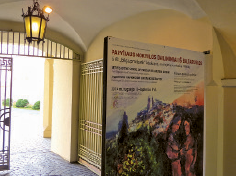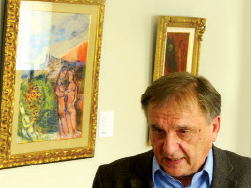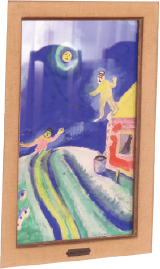Until 2012, Belarus owned not a single original work by Marc Chagall; now, it possesses several. The Belarus-born painter’s artistry is known worldwide, with his masterpieces gracing the globe’s leading galleries and private collections.

Exhibition’s playbill decorated with Chagall’s canvas Lovers
Vilnius’ Picture Gallery (4 Didzioji Str.) — a branch of the Lithuanian Art Museum — is currently hosting an exhibition of Chagall’s works, under the title Paris School Artists from Belarus. Until November 9th, 69 works are on show (loaned from Belgazprombank, the National Art Museum and private collections). The exhibition has already been to Minsk and other Belarusian cities but Vilnius’ display includes more recently acquired works — including Chagall’s Sleepwalker (drawn in 1911-1912, in Paris).
 Vilnius was once home to many great artists, as exhibition curator Vladimir Schastny reminds us. A joint Belarusian-Lithuanian cultural centre was situated here a century ago. “Future Paris celebrities studied at Vilno’s Ivan Trutnev Painting School — among them Chaïm Soutine, Sam Zarfin and Robert Genin. Chagall’s destiny was also connected with Lithuania’s Kaunas, where his exhibition was organised in 1922. Actually, the city was his stopping point on his way to Paris. The Lithuanian Ambassador to Moscow — poet Jurgis Baltrušaitis — helped Chagall move from the USSR, also assisting in transporting many of his works to the West.
Vilnius was once home to many great artists, as exhibition curator Vladimir Schastny reminds us. A joint Belarusian-Lithuanian cultural centre was situated here a century ago. “Future Paris celebrities studied at Vilno’s Ivan Trutnev Painting School — among them Chaïm Soutine, Sam Zarfin and Robert Genin. Chagall’s destiny was also connected with Lithuania’s Kaunas, where his exhibition was organised in 1922. Actually, the city was his stopping point on his way to Paris. The Lithuanian Ambassador to Moscow — poet Jurgis Baltrušaitis — helped Chagall move from the USSR, also assisting in transporting many of his works to the West.At the exhibition opening, the Director of the Lithuanian Art Museum, Romualdas Budrys, admitted, “It’s been a true revelation for me to know that canvases created by artists who lived in Vilnius are found so nearby: in Belarus. On learning this, I decided that these pictures should be exhibited in the city which played a major role in their authors’ life.”
 As the Chairman of Belgazprombank Board, Victor Babariko, noted, although the artists made names for themselves far beyond their historical homeland, ‘Belarus is a country in which geniuses are born’. He views the present co-operation with Lithuania as a foundation on which to build, as ‘our countries have been closely connected by historical links since the time of the Grand Duchy of Lithuania’.
As the Chairman of Belgazprombank Board, Victor Babariko, noted, although the artists made names for themselves far beyond their historical homeland, ‘Belarus is a country in which geniuses are born’. He views the present co-operation with Lithuania as a foundation on which to build, as ‘our countries have been closely connected by historical links since the time of the Grand Duchy of Lithuania’.The Director of the National Art Museum of Belarus, Vladimir Prokoptsov, guided me along the halls of the Vilnius Picture Gallery, indicating pictures from the 19th-early 20th century. Many of their authors were born or worked in Belarus and focused on common Belarusian-Lithuanian problems. Among them are Franciszek Smuglewicz, Jan Rustem, Kanuty Rusiecki, Walenty Wańkowicz, Mstislav Dobuzhinsky and Juozas Kamarauskas. Moreover, Ferdynand Ruszczyc was a true ‘connecting link’. Mr. Prokoptsov paid special attention to this artist, saying, “Jointly with Lithuania’s Art Museum and Lvov and Warsaw collectors, we plan to organise a major show of Ruszczyc’s works in Minsk, in 2015. Sadly, our museum has only one picture by this artist, entitled Near the Roman Catholic Church.”
Pleasingly, ties with colleagues from neighbouring states make it possible to share exhibitions. Meanwhile, Vilnius continues connecting Belarus and Lithuania.
MT’s reference:
The building of Vilnius’ Picture Gallery (4 Didzioji Str.) is much connected to the history of Belarus. In the 16th century, a house was situated here which was later owned by the Khodkevich family. In 1600, war almost broke out near its walls. Sofia — the last representative of Slutsk’s Olelkovichi family — lived there. The Khodkevichs (her relatives on her mother’s side) agreed to marry her to Janusz Radziwill but failed to keep their word, causing the Radziwills to storm the building. Luckily, Sofia agreed and possible war was averted. The remains of the Slutsk duchess are kept at Minsk’s Holy Spirit Cathedral; the lady joined the community of saints for her patronage of the Orthodox Church.
Until the early 19th century, the Khodkevichs owned the palace but, later, it passed to Wojciech Puslowski. A portrait of the latter — painted by Valenty Vankovich — is kept at Lithuania’s Art Museum and was last year showcased at Minsk’s National Art Museum.
In 1834, the large residence on the crossroads of Didzioji and Boksto streets housed Vilno’s Medical-Surgical Academy and, in 1841, was transformed into flats: from 1919-1981, professors working at Vilno University lived there. Some time later, the building was reconstructed to house a restaurant and, in 1994, the Vilnius Picture Gallery opened.
Profile
Ivan Trutnev (1827-1912)
The artist was born to a peasant family, in Russia’s Kaluga Province. He worked for Moscow collector Pavel Tretyakov and, in 1866, lectured in drawing and calligraphy at the Vitebsk Men’s Gymnasium. The same year, he accepted an invitation to set up a drawing school in Vilno, with the aim of ‘bringing local art into Russian form’.
Ivan focused on various themes, as confirmed by the titles of his pictures: Lithuanian Tavern, Flea Market in Vilno, Kazimirovskaya Fair, On Shabbes Eve, Slums, Jews in the Synagogue, and Alexander II’s Visit to Vilno’s Museum of Antiquity. Icons occupied a special place in his artistry, with the painter creating them for churches in Vilno, Kovno, Minsk and Grodno.
Many artists (not only representatives of the Paris School) studied at Vilno’s Trutnev Painting School: among them Bolesław Bałzukiewicz, Jozef Bałzukiewicz, Antanas Žmuidzinavičius, Juozas Zikaras, Jazep Drozdowicz, Rafał Jachimowicz and Ludomir Sleńdziński.
Trutnev is buried at a cemetery near Vilnius’ St. Yevfrosiniya Polotskaya Church (19 Liepkalnio Str.).











